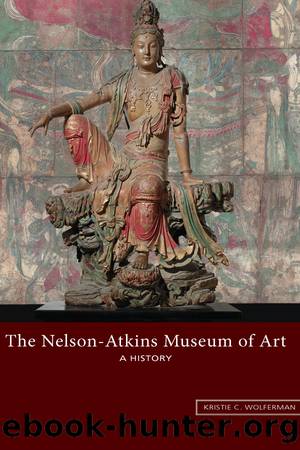The Nelson-Atkins Museum of Art by Kristie C. Wolferman

Author:Kristie C. Wolferman [Wolferman, Kristie C.]
Language: eng
Format: epub
ISBN: 9780826274410
Publisher: University of Missouri Press
Although Jones had a short tenure as a University Trustee, serving only from 1964 to 1969, when he returned full time to his business, he laid a new set of eyes on the museumâs problems and made a positive impact on the museumâs future. As the chief executive of R. B. Jones Insurance Company, one of Cliff Jonesâs first actions was to recuse his company as the primary insurance agency for the museum and solicit bids. Thinking it unwise to put all their eggs in one basket, Jones suggested using three different insurers, an idea that was approved. Also in fall of 1964, Jones acted on a rumor that the Kansas City, Missouri, Earnings Tax was producing more income than expected. The city had already agreed to help Kansas Cityâs historical museum, so Jones wondered if the Nelson-Atkins could benefit too. Superintendent Clarence Simpson had repeatedly talked to the City Engineers Department about the fact that the air conditioning did not âwork properly or effectively.â In March, the University Trustees had invited Ilus Davis, mayor of Kansas City, and Carleton Sharpe, city manager, to lunch at the River Club to discuss the major expense of replacing the air conditioning, estimated to be around $200,000; the two men âindicated a friendly interest in the matter.â The air conditioning problem needed more, however, than just âfriendly interest,â so Jones informed McGreevy and Blackwell that he had phoned Sharpe to reiterate that which Nelson-Atkins needed, a conversation in which he also mentioned the rumor he had heard about the city now having the money on hand. Jones concluded the call by offering Sharpe the use of the museum for an upcoming dinner party the city manager had planned for the Missouri State Legislature. Soon thereafter, the city agreed to do phase one of the air conditioning repairs for $56,582 and provide $10,000 that year for upkeep of the grounds.27
Jones also suggested to McGreevy and Blackwell that they set up âa planning sessionâ with Sickman and staff, âwith emphasis on the direction the gallery might take in the future.â He cited an article from Management News and explained the success that R. B. Jones had enjoyed with such meetings. Points of discussion, Jones suggested, should include ideas for making the Nelson-Atkins Museum of Art more prominent as the center of an art and cultural district, certainly a concept that had been floating around for many years, and, also, how to sell the museum to a wider audience and gain more corporate support. He threw out the idea of âvisual sellingâ by setting up a very small mock gallery âin run-down and terrible shape with miserable pictures hanging on torn, smeared walls,â and having a tour guide say, âBehold, this is what could happen to the Nelson Gallery throughout if the business leaders of the community donât care enough to give just very moderate corporate support.â Jones thought this sales pitch could be a powerful motivator, but luncheons with corporate executives, a more conventional approach, might also work.
Download
This site does not store any files on its server. We only index and link to content provided by other sites. Please contact the content providers to delete copyright contents if any and email us, we'll remove relevant links or contents immediately.
Cecilia; Or, Memoirs of an Heiress — Volume 1 by Fanny Burney(32023)
Cecilia; Or, Memoirs of an Heiress — Volume 3 by Fanny Burney(31438)
Cecilia; Or, Memoirs of an Heiress — Volume 2 by Fanny Burney(31382)
The Great Music City by Andrea Baker(30641)
We're Going to Need More Wine by Gabrielle Union(18607)
All the Missing Girls by Megan Miranda(14603)
Pimp by Iceberg Slim(13718)
Bombshells: Glamour Girls of a Lifetime by Sullivan Steve(13667)
Fifty Shades Freed by E L James(12886)
Talking to Strangers by Malcolm Gladwell(12816)
Norse Mythology by Gaiman Neil(12789)
For the Love of Europe by Rick Steves(11333)
Crazy Rich Asians by Kevin Kwan(8862)
Mindhunter: Inside the FBI's Elite Serial Crime Unit by John E. Douglas & Mark Olshaker(8665)
The Lost Art of Listening by Michael P. Nichols(7125)
Enlightenment Now: The Case for Reason, Science, Humanism, and Progress by Steven Pinker(6852)
The Four Agreements by Don Miguel Ruiz(6284)
Bad Blood by John Carreyrou(6255)
Weapons of Math Destruction by Cathy O'Neil(5801)
